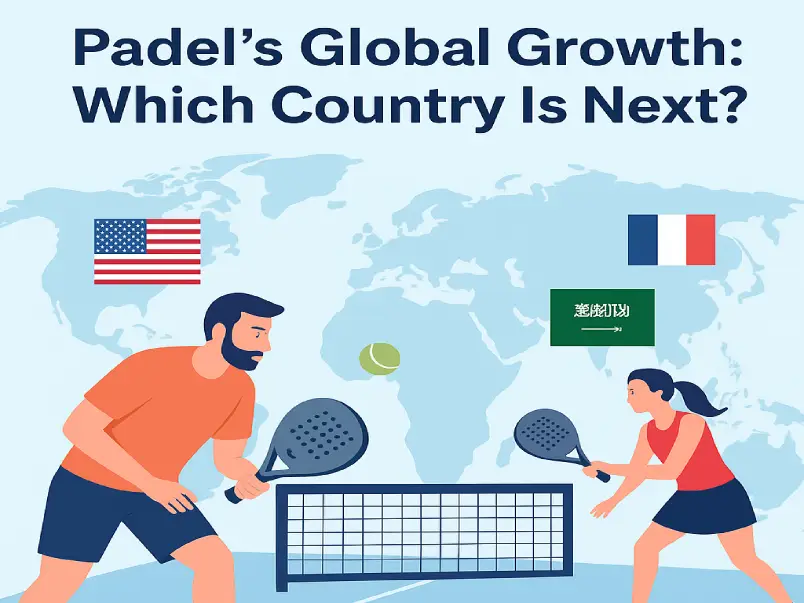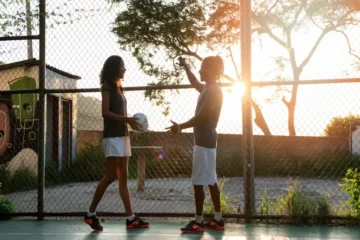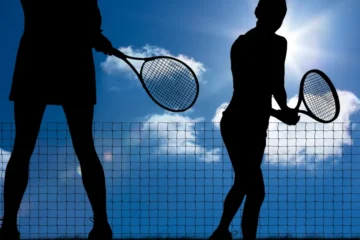The world’s fastest-growing sport is not what you think — it may not be basketball, cricket, or even pickleball. It’s padel. According to the International Padel Federation (FIP), there are now over 70,000 padel courts globally, more than 23,000 padel clubs, and an estimated 30 million players worldwide.
What’s striking is how fast these numbers have scaled in just a few years. From fewer than 8 million players in 2018 to over 30 million today — padel has gone from niche to major.
For those new to the sport: padel is a hybrid of tennis and squash, typically played in doubles on a compact glass- and mesh-walled court. The ball can rebound off the walls, encouraging dynamic rallies. It’s relatively easy to learn, less physically punishing on joints than full-court tennis, and very social — in many places more of a fun-fitness lifestyle activity than an elite competitive sport (though the pro circuit is growing fast).
So here’s the core question: Spain and Sweden have been long-established powerhouses. Italy, the UK, Argentina, and several South American nations are seeing strong growth. But where will the next major wave of padel growth occur?
The Engine of Growth: Why Padel Is So Infectious
Before naming contenders, it helps to understand why padel spreads so fast.
- Low Barrier to Entry.
You don’t need elite athleticism or years of training to pick up padel. The court is smaller, the pace is engaging but manageable, and the gear is simpler. For many beginners, the learning curve is shorter than for tennis or squash. That lowers friction for adoption. - The Social Catalyst.
Padel is typically played in doubles, which encourages sociability. Players chat between points, share the court, and often treat matches as social occasions. Clubs with cafés, bars, pro shops, and social areas are common. This helps retention: once people try it, many keep coming back. - Commercial Viability.
Compared to tennis, building padel courts tends to cost less per usable court area and requires less land. Indoor courts can be fitted in warehouses or existing structures. Developers see opportunities in leisure, sports, and real-estate adjacent sectors. Also, multi-court padel clubs are more compact, more rentable. - The “Cool Factor.”
Celebrity endorsements, pro players, high-visibility events and tournaments are feeding demand. When public figures, footballers, actors are seen playing padel in Spain, Mexico, or even Saudi Arabia, it gives the sport visibility beyond the usual racket-sports circles.
These engines combine to make padel “sticky” — people try it, like it, tell friends. Studies suggest very high return rates after trial sessions.
The Blueprint for Success: Lessons from Established Markets
Looking at countries where padel is already strong reveals a combination of factors that tend to lead to successful, sustained growth.
Case Study 1: Spain (The Heartland)
- Deep Cultural Integration. Padel courts are everywhere: public parks, private clubs, commercial fitness centers. It’s part of leisure culture.
- Widespread Public Courts and Accessibility. Many municipalities build courts; many clubs are affordable. Social and amateur play are strong alongside professional circuits.
- Strong Professional Circuit and Media Coverage. Tournaments get TV coverage, players are known, stars emerge. Media amplifies visibility.
- Structural Support. Spain has a mature federation infrastructure, coaching pathways, tournaments at many levels.
Case Study 2: Sweden & Scandinavia (The Adoption Model)
- Indoor Facilities for All-Weather Play. Because of colder climates, indoor padel courts help ensure year-round play.
- Club Culture & Community. Strong tradition of club membership in sports; padel fits nicely into social sports clubs with multi-sport offerings.
- Federation & Policy Backing. Early inclusion in national sport federations, grants, funding, organizational support for tournaments, leagues.
- Demand and Visibility. Regular tournaments, local leagues, and celebrity or public figure participation help drive awareness.
Key Takeaways
From these models, we can see that for padel to really take off, the following are essential:
- Accessible, affordable courts (both public and private)
- Year-round usability (indoor or otherwise)
- Strong national federations or governing bodies that help organize competitions, coaching, and media rights
- Visible role models or celebrity endorsements
- Media coverage and tournaments to build hype and legitimacy
The Front-Runners: Countries On The Cusp of a Boom
Here are several countries or regions that, based on data and current developments, seem poised to become the “next big thing” in padel.
Contender 1: The United States
Pros:
- Huge market size, high disposable income, established culture of sports and fitness.
- Investors are beginning to notice: more courts are being built, clubs opened.
- Young, urban populations, immigrant communities familiar with padel from Latin America and Europe, plus general fitness culture, may be more likely to adopt.
Challenges:
- Competition from Pickleball. Pickleball is exploding, especially among recreational players, seniors, and in urban/suburban settings. It’s smaller, easier to build, lower cost per court. That gives padel a harder task.
- Land, real estate, regulatory and zoning issues. Finding space (indoor or outdoor), getting zoning, high land costs can be barriers.
- Awareness. Despite growth, many Americans still don’t know what padel is or where to play. Visibility (media, celebrity) lags compared to Europe or Latin America.
Current Traction:
- In early 2025, the U.S. had over 650 courts across 31 states.
- USPA (United States Padel Association) membership jumped from 163 in 2020 to 1,917 in 2024. Amateur participation over 100,000. Padel United Sports Club+1
- New clubs and dedicated facilities are being built. Projects in places like Arizona and the Southwestern states are showing success.
Contender 2: Germany
Pros:
- Europe’s largest economy, with significant purchasing power and interest in racket sports (tennis, badminton, table tennis).
- Strong infrastructure and club culture; many Germans participate in sports clubs.
- High disposable income, urban populations open to new lifestyle sports.
Challenges:
- Slower initial uptake compared to neighbors (Spain, Italy, France). Less awareness.
- Regulatory and bureaucratic hurdles (permits, zoning, local sport governance) can slow down construction or club approvals.
- Competition from well-established sports and limited land or high real estate costs in urban areas.
Current Traction:
- Germany has seen steady increases in court construction. It is one of the European countries where court numbers are rising fast, though still behind the top tier like Spain or Italy.
- Media interest is growing; tournaments, small circuits are developing.
Contender 3: Saudi Arabia & The UAE (The Gulf Region)
Pros:
- Strong government investment in sports under broader modernization / diversification policies (e.g. Saudi Vision 2030). Padel is a part of that mix.
- Favorable climate for year-round outdoor courts, plus ability to build world-class indoor facilities.
- High income levels and appetite for luxury and lifestyle sports facilities. Padel can be tied to tourism, resorts, prestige.
Challenges:
- Grassroots traction: moving from top-level, high-investment, showpiece courts, to community-level access, schools, amateur play. Top-down investment is necessary but not sufficient.
- Cultural adaptation: while padel is relatively easy to adopt, it still requires social spaces and community building. Ensuring that clubs are accessible and appealing to wide demographics (including women, youth) is important.
- Sustainability: ensuring these are not “one-off” projects but consistent network growth.
Current Traction:
- Saudi Arabia has become Asia’s leading country for padel courts. In 2024, it had 431 facilities and 1,097 courts, with approximately 400,000 amateur players.
- There are over 320 padel clubs in Saudi Arabia; over 900 courts at an earlier count, with projections to grow further.
- The Saudi Padel Committee has set strategic goals: e.g. registering 5,000 players in local competition, reaching half a million practitioners, installing 1,000 courts across many cities and regions.
Contender 4: France
Pros:
- Neighbor to Spain, so cultural proximity. France already has strong traditions in tennis, badminton, squash.
- A growing middle class interested in lifestyle sports; media and sports enterprises are interested in padel.
- Geographic advantages: good weather in Southern France for outdoors, and potential for indoor courts elsewhere.
Challenges:
- Tennis is deeply entrenched; many courts, clubs, media, federations etc. Padel has to compete for mindshare.
- Real estate / cost issues in urban centers. Building new courts can be cost-intensive.
- Legislative/regulatory support may lag; federations need to incorporate padel fully.
Current Traction:
- The number of clubs in France has been increasing rapidly. France is among European countries surpassing 1,000 courts. newsletter.padelbusinessmagazine.com
- Local media coverage, some tournaments, increasing public awareness.
IV. The Dark Horses: Unexpected Markets to Watch
Beyond the front-runners, some “under the radar” countries or regions are primed to surprise.
- Egypt & North Africa. Egypt has proximity to Europe, growing middle class, supportive climate. Clubs already exist; expansion in courts and players is underway. Morocco, Tunisia also show signs of growth.
- Mexico & Brazil. Latin America has long been a padel stronghold (Argentina especially). But Mexico and Brazil are now expanding (courts, clubs, tournaments). Mexico is especially noted for “experiencing a padel boom”.
- Japan & South Korea. These countries have shown strong patterns of adopting niche sports and lifestyle trends. High density cities, appetite for leisure sports, plus rising interest in racket sports beyond tennis could help padel gain a foothold. While current court numbers are smaller, growth potential is high.
- Asia-Pacific more broadly. Indonesia, Thailand, Pakistan, China are mentioned in FIP reports as countries where padel is rapidly growing. Although infrastructure is often the bottleneck, interest is increasingly strong.
V. The Verdict: Which Country Has the Winning Formula?
With the above contenders and dark horses in view, which country is most likely to be *the next padel powerhouse over the next 3-5 years?
Here’s a comparative analysis:
| Country / Region | Market Size & Potential | Current Traction | Challenges | Unique Advantages |
|---|---|---|---|---|
| USA | Very high ceiling; population, wealth, fitness culture | Rapid increase in courts, club growth; USPA membership rising; clubs in urban centers expanding | Strong competition from pickleball; awareness; cost of land, real estate; zoning issues | Big investment potential; demographic diversity; possibility of lifestyle branding; media opportunities |
| Saudi Arabia / UAE (Gulf Region) | Moderate to high, especially in Middle East / Asia region; fast growth possible | Strong government support; large number of new courts and clubs; ambitious goals set by federations | Building grassroots culture; making sport accessible; ensuring continuity beyond flagships; balancing social inclusion | Wealth & willingness to invest; favorable climate; governmental alignment (sports strategy); ability to build “destination” clubs/resorts |
| Germany | Large, stable, affluent; strong potential given European proximity | Steady growth in court numbers; growing federation participation; increasing awareness | Real estate / cost challenges; slower cultural shift; established competition from other sports | Commitment to sport clubs; strong middle-class demand; possibility to scale regionally once hubs are established |
| France | Close neighbor to established padel countries; media interest; large population | Courts surpassing 1,000; clubs increasing; tournaments being held; local media & sports entities showing interest | Deep competition from tennis; cost; awareness outside southern regions; infrastructure in colder/climate-challenged areas | Cultural adjacency to Spain; possibility of strong southern hubs; ability to leverage tennis legacy / facilities |
Prediction: While the United States may have the highest ceiling long term, Saudi Arabia and the UAE look likely to be the most explosive in headline, fast-track growth over the next 3 to 5 years. The combination of investment, climate, government strategy, wealth, and the ability to build world-class facilities gives the Gulf Region a strong advantage. Germany represents the most stable organic growth story in Europe, and France looks well-positioned, especially in the south. If the U.S. manages to scale up awareness, build more courts, and navigate competition from pickleball, it could be very significant — but its path looks more gradual compared to the Gulf model.
Conclusion: The Global Court Is Waiting
Padel’s appeal is that it’s not just a sport but an experience: movement, strategy, social interaction, constant rallies, and spaces to belong. These qualities give it universal potential. As data shows, padel clubs are opening at an average of nearly nine per day globally. Courts and clubs are multiplying, and new federations are joining.
The question is no longer if padel will become a mainstream global sport; it’s how fast, and where. From the sun-soaked courts of Spain to the indoor arenas of Sweden; from luxury resorts in Dubai to community clubs in Mexico City — the sport’s next great chapter is being written now.
Saudi Arabia and the UAE are leading the charge for explosive growth, Germany offers steady organic development, the U.S. holds vast promise but will need to overcome key hurdles. Meanwhile, dark horses like Brazil, Egypt, and Asian markets could spring surprises.
So as padel courts pop up in new cities and nations — expect some to stay small and local, others to rise quickly and dominate. The race for the title of Next Padel Nation is officially on. Who will you place your bets on?
❓ FAQs
1. What is driving padel’s global growth?
Padel’s rise is fueled by its easy learning curve, social appeal, affordable court construction, and celebrity endorsements that boost visibility worldwide.
2. Which countries currently lead in padel popularity?
Spain remains the heartland of padel, followed by Sweden, Italy, and Argentina. These nations have well-established infrastructures and active federations.
3. Which country is expected to be the next big padel market?
Saudi Arabia and the UAE are projected to see the fastest padel expansion due to strong investment, favorable climate, and government-backed sports initiatives.
4. How is the United States adapting to the padel trend?
The U.S. padel market is rapidly growing, with major clubs opening in Miami, New York, and California—but it faces competition from pickleball’s dominance.
5. Why is padel so popular compared to tennis?
Padel is easier to learn, less physically demanding, and more social than tennis. It’s perfect for mixed-age, doubles-based recreational play.
6. What challenges could slow padel’s global expansion?
Key obstacles include high land and construction costs in cities, limited awareness in new markets, and competition from other racket sports like pickleball.
7. Are there emerging regions to watch in padel growth?
Yes—North Africa, Mexico, Brazil, and parts of Asia such as Japan and South Korea are emerging as strong contenders for future padel development.
8. Will padel become an Olympic sport?
The International Padel Federation is pushing for Olympic inclusion. With growing global participation, experts predict it could happen within the next decade.




